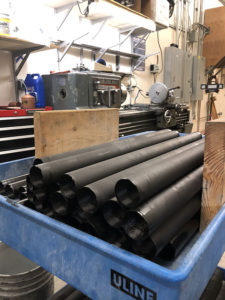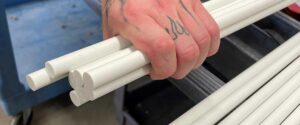Master Guide to Composite Materials Manufacturing
Composite materials have significantly transformed the manufacturing and design industries by providing several breakthroughs and solutions. Composites combine two or more materials to form a stronger and higher quality material appropriate for a certain application. Due to exceptional strength, durability, and lightweight characteristics, composite materials are widely employed in the aerospace, automotive, marine, and construction sectors.
This guide will cover the fundamentals of composite materials production, including their many types and benefits and the manufacturing process.
Types of Composite Materials
Composite materials occur in various forms, each with its own set of qualities and advantages. The following are the most prevalent composite materials:
- Fiberglass Composites: Fiberglass composites are strong, rigid, and long-lasting because they are made by mixing glass fibers with a polymer matrix. These characteristics make them ideal for the construction, maritime, and transportation industries.

- Carbon Composites: Due to the combination of carbon fibers with a polymer matrix, carbon composites offer great strength, stiffness, and fatigue resistance at light weight. As such, they are the preferred material in industries such as aircraft, automobiles, and sports equipment.
- Ceramic Composites: These composites, which combine ceramic fibers with a ceramic matrix, offer outstanding wear resistance and great strength, even in high-temperature applications. Ceramic composites are commonly used in aerospace, energy, and transportation applications.
- Metal Matrix Composites (MMC): MMCs get a high level of stiffness, exceptional wear resistance, and a high strength-to-weight ratio when metal alloys and ceramic fibers or particles combine. This makes them ideal for aeronautical, automotive, and military applications.
- Natural Fiber Composites: Natural fibers paired with a polymer matrix yield environmentally benign, lightweight, and low-cost materials appropriate for furniture, packaging, and building.
Benefits of Composite Materials
Composite materials offer several advantages over traditional materials. These include the following:
High Strength-to-Weight Ratio
Composites can attain greater strength than traditional materials — such as steel or aluminum — while being significantly lighter. This is accomplished by reinforcing fibers with a matrix material. As a result, composite materials are appropriate for applications requiring low weight, such as in the aircraft and automotive sectors.
Corrosion Resistance
Composite materials are also corrosion-resistant, making them an excellent choice for use in harsh environments. They do not rust or corrode, requiring less care during their lifespan. This can save time and money in the long term, especially when maintenance is difficult or expensive.
Design Flexibility
The molding process to generate composite materials makes customization and design flexibility possible. This allows for creating complicated parts and components that would be challenging or impossible to make with traditional materials. Hence, composite materials are useful for various applications across industries.
Fatigue Resistance
Composite materials are fatigue-resistant, withstanding numerous stress cycles without cracking or breaking. Because of this, they are excellent for complex applications.
Reduced Tooling Costs
Composite materials require less tooling than conventional materials, which can reduce manufacturing costs. In addition, with the capacity to readily mold composite materials into complicated forms, there is less need for expensive tooling equipment. Typically, this results in cost reductions without sacrificing or compromising quality.
Steps in Manufacturing Composite Materials
The production of composite materials is a complex and crucial process that comprises multiple methods to guarantee that the finished product fulfills the required standards. The steps involved in the manufacturing process are as follows:
Step #1: Design
Designing the composite material is an important stage that impacts the final product’s performance and attributes. First, engineers choose suitable primary materials depending on the application. Then, they determine the production process, define the layup and orientation of the reinforcing fibers, and specify the desired size and shape of the completed product. This guarantees that a well-designed composite material can endure the anticipated loads, pressures, and environmental variables.
Step #2: Material Selection
In this step, the matrix material — commonly a polymer resin — is coupled with the reinforcing material (fiberglass, carbon fiber, or a combination of materials). The attributes of the chosen materials — such as strength, weight, durability, and cost — are carefully considered to guarantee that the finished product operates adequately.
Step #3: Production
Production of composites can include prepreg, pultrusion, vacuum bagging, and filament winding, to name a few. All composite production methods involve combining the composite fiber with the matrix material, usually resin. In pultrusion, this involves pulling linear fibers through a resin bath and a series of dies to create a continuous rod or tube profile. For other production processes, like roll-wrapping or closed molding, this involves the construction of prepreg. Prepreg is a sheet of fibers pre-impregnated with the matrix material. The resin is applied to the reinforcing material and then frozen, resulting in a sturdy and solid material ready for use. Afterward, the pre-impregnated reinforcing material is trimmed to size for the layup.
Step #4: Layup
During layup, the reinforcing material is applied in a specified pattern to provide the required form and strength of the end product. This procedure is performed by hand or with the assistance of an automated machine. The layup procedure involves layering the pre-impregnated material to get the appropriate thickness and form.
Step #5: Curing
The curing process entails applying heat and pressure to the composite material to guarantee that the matrix material cures and hardens completely. Depending on the resin type, the composite’s thickness, and the final product’s required qualities, this manufacturing step might take several hours to a few days.
Step #6: Machining
After curing, the composite material is machined to the appropriate form and size using specialized equipment such as CNC machines. This procedure involves cutting the composite material to the desired dimensions, drilling holes, and shaping it to fit the requirements.
Why Choose Goodwinds Composites
Investing in a composite material manufacturer can be rewarding for entrepreneurs wishing to make a material investment. Here are some of the reasons why Goodwinds Composites is the ideal solution for your company:
Dedication to Excellence
At Goodwinds Composites, we guarantee that every product we manufacture or sell meets the highest quality standards. All parts and components are double- and triple-checked before leaving our plant, ensuring that clients can rely on us to consistently provide top-notch goods.
USA-Sourced and Manufactured Products
Goodwinds Composites’ whole product line is sourced and produced in the United States. This may be significant to customers who value domestic production and wish to support American enterprises. Moreover, it streamlines production and delivery processes and times, allowing easier collaboration and communication.
Competent Team
Goodwinds Composites is proud of its skilled workforce, including composites engineers and machining specialists. We are committed to creating and producing unique items for our customers, with expertise working on both small and large-scale projects. Thus, we can meet a wide variety of custom requests and specifications.
Convenient Location
Based in Skagit Valley — a commercial center for machining, aerospace, and marine technologies — we are in a perfect position to cooperate with other regional companies. Goodwinds Composites works hard to keep current on industry trends and innovations.
Goodwinds Composites: Your Partner in Composite Manufacturing
Goodwinds Composites is an esteemed company specializing in tailor-made composite materials sourced and produced in the United States. With our wealth of knowledge and engineering expertise, we can provide valuable guidance and build a practical, cost-effective solution for your application. Our goal is to meet your specific needs, whether it’s a basic tube or a complex, high-tech structure.
Our team of experienced engineers is available to assist you every step of the way! We have experts and specialists to guide you through brainstorming and design, material selection, product development, and final bonding and assembly.
Don’t settle for off-the-shelf composites, and let us engineer a custom solution for your unique application! Contact us today to learn more about our comprehensive products and services.


